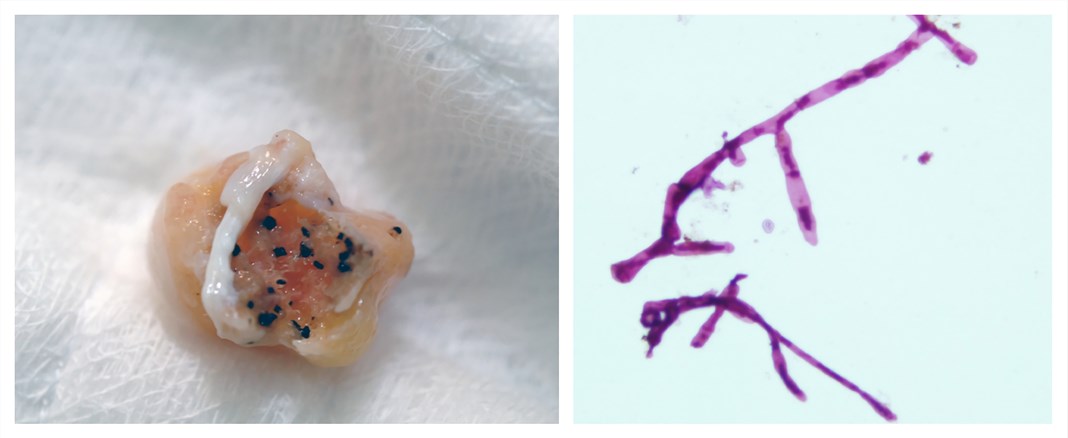Eumycetoma
Development of antifungal agents remains an important priority in the pharmaceutical research industry. As a global CRO specializing in antifungal drug discovery services, Creative Biolabs provides a comprehensive portfolio of services, ranging from target identification and validation to IND enabling studies. We focus on a wide range of fungal diseases, including mycetoma, and a wide spectrum of potential drug targets, including cell wall targets, cell membrane targets, biosynthetic pathway, virulence factors, etc. Here, we give a brief introduction of the mycetoma caused by fungi (eumycetoma).
Introduction to Mycetoma & Eumycetoma
Mycetoma is a mutilating, chronic, granulomatous infection seen in tropical and subtropical areas. It is a disorder of subcutaneous tissue, skin, and bones, mainly of feet, characterized by a triad of localized swelling, underlying sinus tracts, and production of grains or granules. It can be caused by either bacteria (actinomycetoma) or fungi (eumycetoma). The most common causative agent of eumycetoma worldwide is Madurella mycetomatis. The infection most probably starts after a small trauma which introduces the causative agents into the subcutaneous tissue. Therefore, barefoot walking people in poor areas in the tropics and subtropics are most commonly affected.
Diagnosis of Eumycetoma
Identification of the causative organism and the disease extension are the first steps for disease management and prognosis. Different laboratory-based diagnostic tools have been developed for this purpose, including direct microscopy of grains, cytological identification, histopathological and histochemical techniques, ultrasonography, as well as molecular-based techniques. These diagnostic techniques are of various specificity and sensitivity rates, and a combination of them is always required to reach a diagnosis. Conclusively, there is a lack of simple, accurate, reliable, cost-effective, and field-friendly diagnostic tests.
 Fig.1 Photograph of surgical biopsy showing a well-encapsulated eumycetoma lesion with numerous black grains (left). KOH wet mount direct microscopic examination of M. mycetomatis grains showing its hyphal structure (right).1
Fig.1 Photograph of surgical biopsy showing a well-encapsulated eumycetoma lesion with numerous black grains (left). KOH wet mount direct microscopic examination of M. mycetomatis grains showing its hyphal structure (right).1
Treatment of Eumycetoma
Actinomycetomas are usually amenable to antibiotic treatment. Frequently used antibiotics include dapsone, streptomycin, trimethoprim, and rifampicin. However, eumycotic mycetomas usually respond less well to drug therapy, and therefore treatment of eumycetoma is mostly achieved by a combination of antifungal agents together with surgical procedures. Complete surgical excision of the lesion followed by antifungal therapy should form the first line of management in eumycotic mycetoma. Itraconazole is the treatment of choice and usually, this treatment is performed for 1-2 years.
Features of our Services
Due to the limitations of the existing antifungal therapies, the need to discover and develop antifungal agents that are efficacious to treat mycetoma caused by fungi, with improved safety and exposure, remains unmet. As a leading research partner who is dedicated to antifungal drug discovery and development, Creative Biolabs develops and delivers state-of-the-art integrated antifungal drug discovery services to assist in the development of antifungals against novel targets. We provide services that are characterized by:
- High quality - robust, efficient processes combined with quality systems
- Expertise - scientists and staff with unrivaled expertise and hands-on experience
- Versatile - focuses on a wide range of fungal diseases, pathogens, and potential drug targets
- Flexibility - customized study designs to meet your specific needs
With years of experience serving the pharmaceutical and biotechnology community, Creative Biolabs provides superior data reliability and innovative solutions to help expand your project value. If you are interested in our services, please contact us or send us an inquiry.
Reference
- Ahmed, Amel Altayeb, Wendy van de Sande, and Ahmed Hassan Fahal. "Mycetoma laboratory diagnosis." PLoS neglected tropical diseases 11.8 (2017): e0005638. Distributed under Open Access license CC BY 4.0, without modification.
For Research Use Only.
